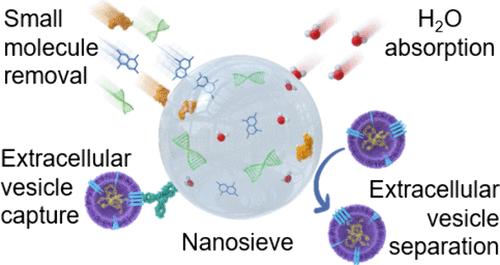当前位置:
X-MOL 学术
›
ACS Appl. Mater. Interfaces
›
论文详情
Our official English website, www.x-mol.net, welcomes your
feedback! (Note: you will need to create a separate account there.)
Advanced Enrichment and Separation of Extracellular Vesicles through the Super Absorbent Polymer Nanosieves
ACS Applied Materials & Interfaces ( IF 8.3 ) Pub Date : 2024-11-19 , DOI: 10.1021/acsami.4c14542 Yoo Min Ham, Yubin Kang, Su Jin Kang, Soobin Lee, Ji Yoon Lee, Won Jong Rhee
ACS Applied Materials & Interfaces ( IF 8.3 ) Pub Date : 2024-11-19 , DOI: 10.1021/acsami.4c14542 Yoo Min Ham, Yubin Kang, Su Jin Kang, Soobin Lee, Ji Yoon Lee, Won Jong Rhee

|
Extracellular vesicles (EVs) are promising therapeutic biomaterials capable of transferring their cargo molecules and external drugs to other cells in vivo and contain various biomarkers that can be used in liquid biopsies. The clinical application of EVs requires an efficient EV enrichment system for the large-scale production or high-throughput isolation of EVs from liquid samples, such as culture media, plant juices, and body fluids. However, current EV enrichment methods, such as ultrafiltration and ultracentrifugation, have limited applicability owing to their associated costs, inefficiency, scalability, and centrifugation time. Herein, we describe the development of a nanosieve based on a superabsorbent polymer for selective EV enrichment. The nanosieve absorbs small molecules while expelling large molecules, such as EVs, through the nanosized channels. We successfully concentrated EVs from clinical samples, such as serum and plasma, with superior cost and time efficiencies. The nanosieves did not interact with the EVs during enrichment, allowing the retention of their therapeutic functions. In addition, the nanosieve surface was specifically engineered to provide multifunctionality to effectively promote EV capture from bulk solutions. Overall, our nanosieve-based EV enrichment method is effective, time- and cost-saving, versatile, scalable, and modulable, and is an excellent option for EV production.
中文翻译:

通过高吸水性聚合物纳米筛对细胞外囊泡进行高级富集和分离
细胞外囊泡 (EV) 是一种很有前途的治疗性生物材料,能够将其货物分子和外部药物转移到体内其他细胞,并包含可用于液体活检的各种生物标志物。EV 的临床应用需要高效的 EV 富集系统,以便从液体样品(如培养基、植物汁液和体液)中大规模生产或高通量分离 EV。然而,目前的 EV 富集方法,如超滤和超速离心,由于其相关成本、效率低下、可扩展性和离心时间等原因,适用性有限。在本文中,我们描述了基于高吸水性聚合物的纳米筛的开发,用于选择性 EV 富集。纳米筛吸收小分子,同时通过纳米通道排出大分子,例如 EV。我们成功地浓缩了来自临床样本(如血清和血浆)的 EV,具有卓越的成本和时间效率。纳米筛在富集过程中不与 EV 相互作用,从而保留了它们的治疗功能。此外,纳米筛表面经过专门设计,可提供多功能性,以有效促进从散装溶液中捕获 EV。总体而言,我们基于纳米筛的 EV 富集方法有效、省时、节省成本、用途广泛、可扩展且可调制,是 EV 生产的绝佳选择。
更新日期:2024-11-19
中文翻译:

通过高吸水性聚合物纳米筛对细胞外囊泡进行高级富集和分离
细胞外囊泡 (EV) 是一种很有前途的治疗性生物材料,能够将其货物分子和外部药物转移到体内其他细胞,并包含可用于液体活检的各种生物标志物。EV 的临床应用需要高效的 EV 富集系统,以便从液体样品(如培养基、植物汁液和体液)中大规模生产或高通量分离 EV。然而,目前的 EV 富集方法,如超滤和超速离心,由于其相关成本、效率低下、可扩展性和离心时间等原因,适用性有限。在本文中,我们描述了基于高吸水性聚合物的纳米筛的开发,用于选择性 EV 富集。纳米筛吸收小分子,同时通过纳米通道排出大分子,例如 EV。我们成功地浓缩了来自临床样本(如血清和血浆)的 EV,具有卓越的成本和时间效率。纳米筛在富集过程中不与 EV 相互作用,从而保留了它们的治疗功能。此外,纳米筛表面经过专门设计,可提供多功能性,以有效促进从散装溶液中捕获 EV。总体而言,我们基于纳米筛的 EV 富集方法有效、省时、节省成本、用途广泛、可扩展且可调制,是 EV 生产的绝佳选择。


















































 京公网安备 11010802027423号
京公网安备 11010802027423号